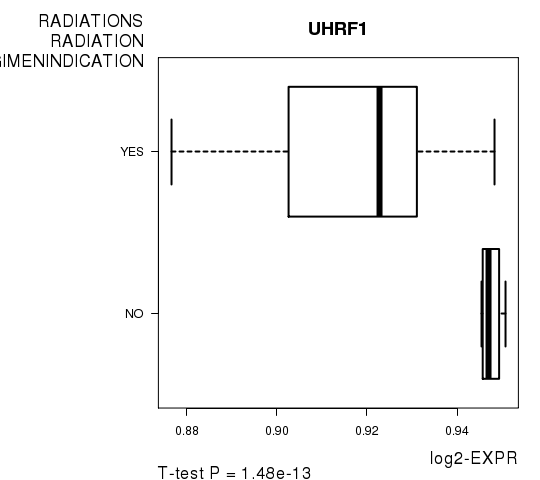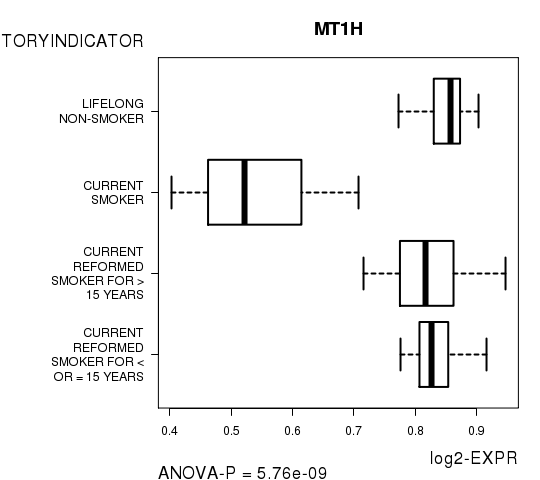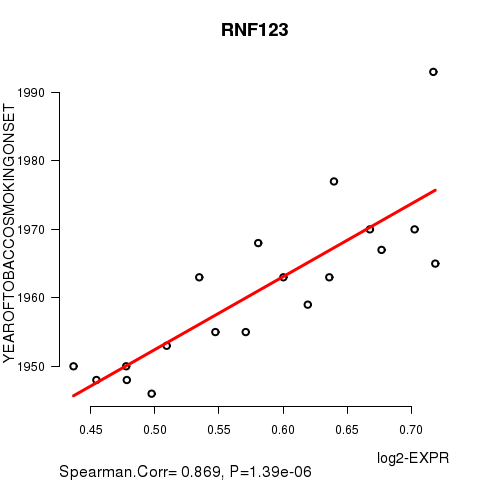This pipeline uses various statistical tests to identify genes whose promoter methylation levels correlated to selected clinical features.
Testing the association between 17281 genes and 14 clinical features across 62 samples, statistically thresholded by Q value < 0.05, 6 clinical features related to at least one genes.
-
2 genes correlated to 'GENDER'.
-
RNASEH2C , KIF4B
-
54 genes correlated to 'HISTOLOGICAL.TYPE'.
-
SPAG8 , IVD , TRPV1 , PITX3 , NOD2 , ...
-
75 genes correlated to 'PATHOLOGICSPREAD(M)'.
-
LRRC8B , FBXO16 , NOTCH2 , ZNF563 , LRRC58 , ...
-
52 genes correlated to 'RADIATIONS.RADIATION.REGIMENINDICATION'.
-
UHRF1 , FBXO9 , DMXL1 , PPA1 , MYL6 , ...
-
7 genes correlated to 'TOBACCOSMOKINGHISTORYINDICATOR'.
-
MT1H , SERPINE1 , WFDC10A , EXOC3L , FAM107A , ...
-
1 gene correlated to 'YEAROFTOBACCOSMOKINGONSET'.
-
RNF123
-
No genes correlated to 'Time to Death', 'AGE', 'KARNOFSKY.PERFORMANCE.SCORE', 'PATHOLOGY.T', 'PATHOLOGY.N', 'TUMOR.STAGE', 'NUMBERPACKYEARSSMOKED', and 'STOPPEDSMOKINGYEAR'.
Complete statistical result table is provided in Supplement Table 1
Table 1. Get Full Table This table shows the clinical features, statistical methods used, and the number of genes that are significantly associated with each clinical feature at Q value < 0.05.
| Clinical feature | Statistical test | Significant genes | Associated with | Associated with | ||
|---|---|---|---|---|---|---|
| Time to Death | Cox regression test | N=0 | ||||
| AGE | Spearman correlation test | N=0 | ||||
| GENDER | t test | N=2 | male | N=1 | female | N=1 |
| KARNOFSKY PERFORMANCE SCORE | Spearman correlation test | N=0 | ||||
| HISTOLOGICAL TYPE | ANOVA test | N=54 | ||||
| PATHOLOGY T | Spearman correlation test | N=0 | ||||
| PATHOLOGY N | Spearman correlation test | N=0 | ||||
| PATHOLOGICSPREAD(M) | ANOVA test | N=75 | ||||
| TUMOR STAGE | Spearman correlation test | N=0 | ||||
| RADIATIONS RADIATION REGIMENINDICATION | t test | N=52 | yes | N=21 | no | N=31 |
| NUMBERPACKYEARSSMOKED | Spearman correlation test | N=0 | ||||
| STOPPEDSMOKINGYEAR | Spearman correlation test | N=0 | ||||
| TOBACCOSMOKINGHISTORYINDICATOR | ANOVA test | N=7 | ||||
| YEAROFTOBACCOSMOKINGONSET | Spearman correlation test | N=1 | higher yearoftobaccosmokingonset | N=1 | lower yearoftobaccosmokingonset | N=0 |
Table S1. Basic characteristics of clinical feature: 'Time to Death'
| Time to Death | Duration (Months) | 0.1-224 (median=12.7) |
| censored | N = 36 | |
| death | N = 15 | |
| Significant markers | N = 0 |
Table S2. Basic characteristics of clinical feature: 'AGE'
| AGE | Mean (SD) | 66.58 (11) |
| Significant markers | N = 0 |
Table S3. Basic characteristics of clinical feature: 'GENDER'
| GENDER | Labels | N |
| FEMALE | 37 | |
| MALE | 25 | |
| Significant markers | N = 2 | |
| Higher in MALE | 1 | |
| Higher in FEMALE | 1 |
Table S4. Get Full Table List of 2 genes differentially expressed by 'GENDER'
| T(pos if higher in 'MALE') | ttestP | Q | AUC | |
|---|---|---|---|---|
| RNASEH2C | 5.84 | 7.272e-07 | 0.0126 | 0.8822 |
| KIF4B | -5.34 | 2.092e-06 | 0.0361 | 0.8584 |
Figure S1. Get High-res Image As an example, this figure shows the association of RNASEH2C to 'GENDER'. P value = 7.27e-07 with T-test analysis.

No gene related to 'KARNOFSKY.PERFORMANCE.SCORE'.
Table S5. Basic characteristics of clinical feature: 'KARNOFSKY.PERFORMANCE.SCORE'
| KARNOFSKY.PERFORMANCE.SCORE | Mean (SD) | 43.33 (38) |
| Score | N | |
| 0 | 1 | |
| 60 | 1 | |
| 70 | 1 | |
| Significant markers | N = 0 |
Table S6. Basic characteristics of clinical feature: 'HISTOLOGICAL.TYPE'
| HISTOLOGICAL.TYPE | Labels | N |
| LUNG ACINAR ADENOCARCINOMA | 3 | |
| LUNG ADENOCARCINOMA MIXED SUBTYPE | 13 | |
| LUNG ADENOCARCINOMA- NOT OTHERWISE SPECIFIED (NOS) | 33 | |
| LUNG BRONCHIOLOALVEOLAR CARCINOMA MUCINOUS | 3 | |
| LUNG BRONCHIOLOALVEOLAR CARCINOMA NONMUCINOUS | 4 | |
| LUNG MICROPAPILLARY ADENOCARCINOMA | 1 | |
| LUNG MUCINOUS ADENOCARCINOMA | 1 | |
| LUNG PAPILLARY ADENOCARCINOMA | 2 | |
| MUCINOUS (COLLOID) ADENOCARCINOMA | 2 | |
| Significant markers | N = 54 |
Table S7. Get Full Table List of top 10 genes differentially expressed by 'HISTOLOGICAL.TYPE'
| ANOVA_P | Q | |
|---|---|---|
| SPAG8 | 3.554e-52 | 6.14e-48 |
| IVD | 2.94e-36 | 5.08e-32 |
| TRPV1 | 4.462e-22 | 7.71e-18 |
| PITX3 | 1.187e-20 | 2.05e-16 |
| NOD2 | 3.85e-18 | 6.65e-14 |
| C17ORF64 | 3.286e-17 | 5.68e-13 |
| PIK3CB | 4.148e-16 | 7.17e-12 |
| TRAF3IP1 | 3.609e-15 | 6.23e-11 |
| ZRANB1 | 5.252e-14 | 9.07e-10 |
| C17ORF85 | 8.786e-14 | 1.52e-09 |
Figure S2. Get High-res Image As an example, this figure shows the association of SPAG8 to 'HISTOLOGICAL.TYPE'. P value = 3.55e-52 with ANOVA analysis.

Table S8. Basic characteristics of clinical feature: 'PATHOLOGY.T'
| PATHOLOGY.T | Mean (SD) | 1.93 (0.75) |
| N | ||
| T1 | 16 | |
| T2 | 36 | |
| T3 | 6 | |
| T4 | 3 | |
| Significant markers | N = 0 |
Table S9. Basic characteristics of clinical feature: 'PATHOLOGY.N'
| PATHOLOGY.N | Mean (SD) | 0.54 (0.79) |
| N | ||
| N0 | 39 | |
| N1 | 11 | |
| N2 | 11 | |
| Significant markers | N = 0 |
Table S10. Basic characteristics of clinical feature: 'PATHOLOGICSPREAD(M)'
| PATHOLOGICSPREAD(M) | Labels | N |
| M0 | 44 | |
| M1 | 2 | |
| MX | 14 | |
| Significant markers | N = 75 |
Table S11. Get Full Table List of top 10 genes differentially expressed by 'PATHOLOGICSPREAD(M)'
| ANOVA_P | Q | |
|---|---|---|
| LRRC8B | 1.36e-10 | 2.35e-06 |
| FBXO16 | 7.075e-10 | 1.22e-05 |
| NOTCH2 | 1.447e-09 | 2.5e-05 |
| ZNF563 | 1.582e-09 | 2.73e-05 |
| LRRC58 | 1.711e-09 | 2.96e-05 |
| MREG | 3.227e-09 | 5.58e-05 |
| GPSM2 | 3.849e-09 | 6.65e-05 |
| CRELD2 | 5.289e-09 | 9.14e-05 |
| CYP2R1 | 5.791e-09 | 1e-04 |
| FAM60A | 6.021e-09 | 0.000104 |
Figure S3. Get High-res Image As an example, this figure shows the association of LRRC8B to 'PATHOLOGICSPREAD(M)'. P value = 1.36e-10 with ANOVA analysis.

Table S12. Basic characteristics of clinical feature: 'TUMOR.STAGE'
| TUMOR.STAGE | Mean (SD) | 1.73 (0.91) |
| N | ||
| Stage 1 | 32 | |
| Stage 2 | 13 | |
| Stage 3 | 12 | |
| Stage 4 | 2 | |
| Significant markers | N = 0 |
52 genes related to 'RADIATIONS.RADIATION.REGIMENINDICATION'.
Table S13. Basic characteristics of clinical feature: 'RADIATIONS.RADIATION.REGIMENINDICATION'
| RADIATIONS.RADIATION.REGIMENINDICATION | Labels | N |
| NO | 4 | |
| YES | 58 | |
| Significant markers | N = 52 | |
| Higher in YES | 21 | |
| Higher in NO | 31 |
Table S14. Get Full Table List of top 10 genes differentially expressed by 'RADIATIONS.RADIATION.REGIMENINDICATION'
| T(pos if higher in 'YES') | ttestP | Q | AUC | |
|---|---|---|---|---|
| UHRF1 | -10.25 | 1.48e-13 | 2.56e-09 | 0.9784 |
| FBXO9 | 8.77 | 2.436e-12 | 4.21e-08 | 0.9224 |
| DMXL1 | 10.9 | 1.47e-10 | 2.54e-06 | 0.9784 |
| PPA1 | 7.59 | 1.989e-09 | 3.44e-05 | 0.9052 |
| MYL6 | -7.52 | 3.744e-09 | 6.47e-05 | 0.9138 |
| NCAN | 6.73 | 7.701e-09 | 0.000133 | 0.8362 |
| ZSCAN2 | -6.97 | 1.387e-08 | 0.00024 | 0.875 |
| CIDEC | -6.81 | 1.944e-08 | 0.000336 | 0.8233 |
| ACTR1B | 7.92 | 2.248e-08 | 0.000388 | 0.9009 |
| MRPL55 | 6.63 | 2.423e-08 | 0.000418 | 0.8491 |
Figure S4. Get High-res Image As an example, this figure shows the association of UHRF1 to 'RADIATIONS.RADIATION.REGIMENINDICATION'. P value = 1.48e-13 with T-test analysis.

Table S15. Basic characteristics of clinical feature: 'NUMBERPACKYEARSSMOKED'
| NUMBERPACKYEARSSMOKED | Mean (SD) | 28.14 (29) |
| Significant markers | N = 0 |
Table S16. Basic characteristics of clinical feature: 'STOPPEDSMOKINGYEAR'
| STOPPEDSMOKINGYEAR | Mean (SD) | 1987.25 (15) |
| Significant markers | N = 0 |
7 genes related to 'TOBACCOSMOKINGHISTORYINDICATOR'.
Table S17. Basic characteristics of clinical feature: 'TOBACCOSMOKINGHISTORYINDICATOR'
| TOBACCOSMOKINGHISTORYINDICATOR | Labels | N |
| CURRENT REFORMED SMOKER FOR < OR = 15 YEARS | 13 | |
| CURRENT REFORMED SMOKER FOR > 15 YEARS | 20 | |
| CURRENT SMOKER | 3 | |
| LIFELONG NON-SMOKER | 21 | |
| Significant markers | N = 7 |
Table S18. Get Full Table List of 7 genes differentially expressed by 'TOBACCOSMOKINGHISTORYINDICATOR'
| ANOVA_P | Q | |
|---|---|---|
| MT1H | 5.759e-09 | 9.95e-05 |
| SERPINE1 | 7.632e-09 | 0.000132 |
| WFDC10A | 1.814e-08 | 0.000314 |
| EXOC3L | 2.307e-08 | 0.000399 |
| FAM107A | 2.919e-07 | 0.00504 |
| PRELP | 6.162e-07 | 0.0106 |
| DDR2 | 7.764e-07 | 0.0134 |
Figure S5. Get High-res Image As an example, this figure shows the association of MT1H to 'TOBACCOSMOKINGHISTORYINDICATOR'. P value = 5.76e-09 with ANOVA analysis.

Table S19. Basic characteristics of clinical feature: 'YEAROFTOBACCOSMOKINGONSET'
| YEAROFTOBACCOSMOKINGONSET | Mean (SD) | 1961.21 (12) |
| Significant markers | N = 1 | |
| pos. correlated | 1 | |
| neg. correlated | 0 |
Table S20. Get Full Table List of one gene significantly correlated to 'YEAROFTOBACCOSMOKINGONSET' by Spearman correlation test
| SpearmanCorr | corrP | Q | |
|---|---|---|---|
| RNF123 | 0.8688 | 1.393e-06 | 0.0241 |
Figure S6. Get High-res Image As an example, this figure shows the association of RNF123 to 'YEAROFTOBACCOSMOKINGONSET'. P value = 1.39e-06 with Spearman correlation analysis. The straight line presents the best linear regression.

-
Expresson data file = MOLECULAR_NONSMOKER.meth.for_correlation.filtered_data.txt
-
Clinical data file = MOLECULAR_NONSMOKER.clin.merged.picked.txt
-
Number of patients = 62
-
Number of genes = 17281
-
Number of clinical features = 14
For survival clinical features, Wald's test in univariate Cox regression analysis with proportional hazards model (Andersen and Gill 1982) was used to estimate the P values using the 'coxph' function in R. Kaplan-Meier survival curves were plot using the four quartile subgroups of patients based on expression levels
For continuous numerical clinical features, Spearman's rank correlation coefficients (Spearman 1904) and two-tailed P values were estimated using 'cor.test' function in R
For two-class clinical features, two-tailed Student's t test with unequal variance (Lehmann and Romano 2005) was applied to compare the log2-expression levels between the two clinical classes using 't.test' function in R
For multi-class clinical features (ordinal or nominal), one-way analysis of variance (Howell 2002) was applied to compare the log2-expression levels between different clinical classes using 'anova' function in R
For multiple hypothesis correction, Q value is the False Discovery Rate (FDR) analogue of the P value (Benjamini and Hochberg 1995), defined as the minimum FDR at which the test may be called significant. We used the 'Benjamini and Hochberg' method of 'p.adjust' function in R to convert P values into Q values.
This is an experimental feature. The full results of the analysis summarized in this report can be downloaded from the TCGA Data Coordination Center.